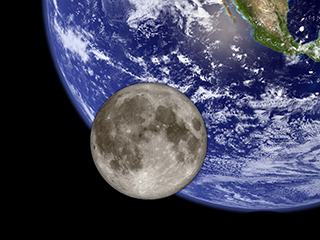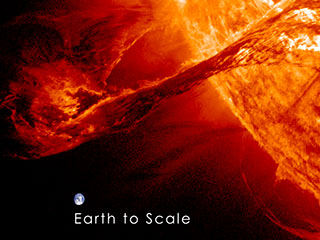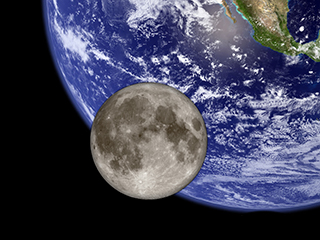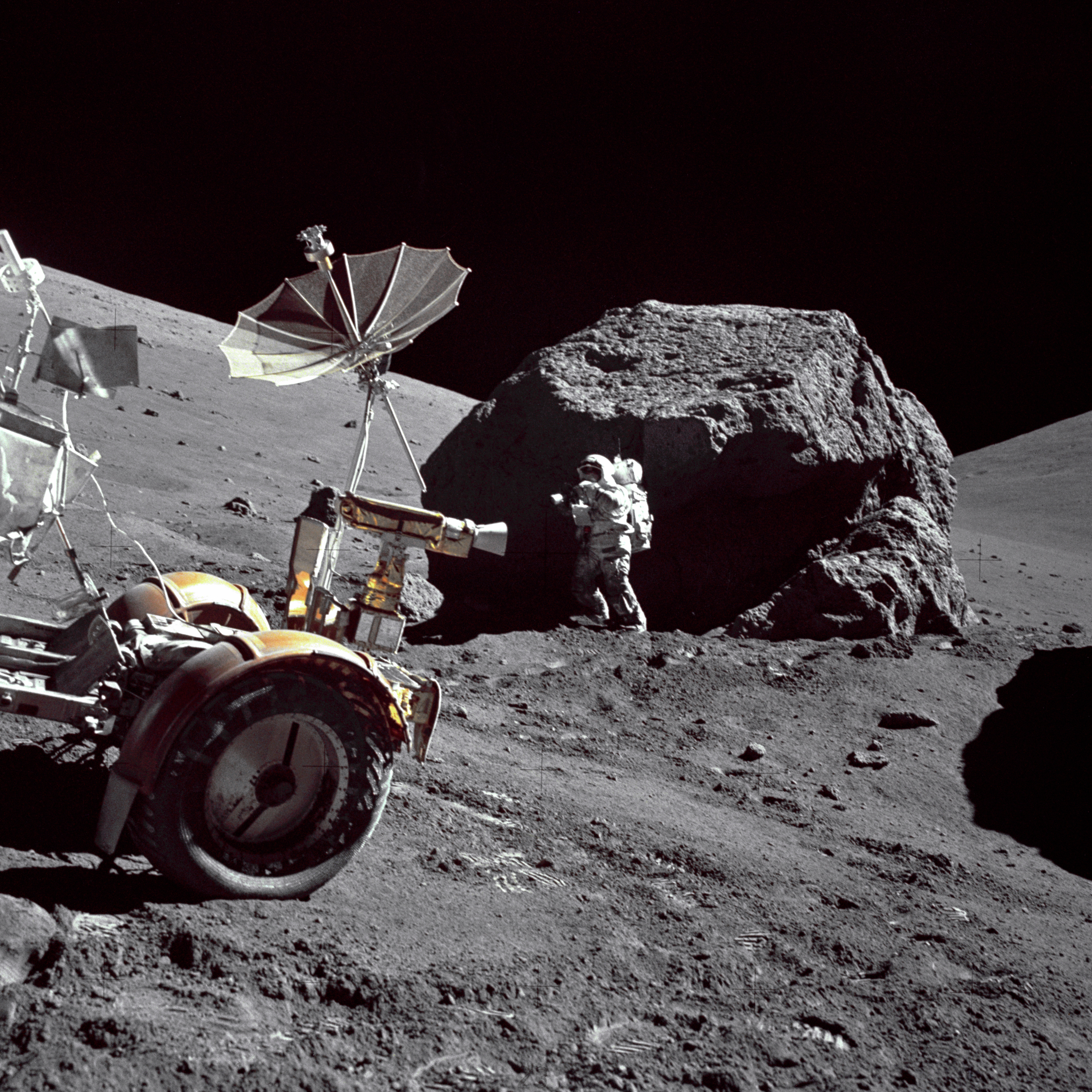Introductory Astronomy for Undergraduates
The Earth and Moon

Credit:NASA
Earth
Earth is the third planet from the sun and the fifth largest in the solar system. Just slightly larger than nearby Venus, Earth is the biggest of the terrestrial planets. Our home planet is the only planet in our solar system known to harbor living things.The name Earth is at least 1,000 years old. All of the planets, except for Earth, were named after Greek and Roman gods and goddesses. However, the name Earth is an English/German word, which simply means the ground.
This page provides a brief overview of our home planet (Source NASA). For a comprehensive look at Earth, visit NASA's Earth Science Division.

Credit:NASA
Size and Distance
With a radius of 3,959 miles (6,371 kilometers), Earth is the biggest of the terrestrial planets, and the fifth largest planet overall.From an average distance of 93 million miles (150 million kilometers), Earth is exactly one astronomical unit away from the sun because one astronomical unit (abbreviated as AU), is the distance from the sun to Earth. This unit provides an easy way to quickly compare planets' distances from the sun.It takes about eight minutes for light from the sun to reach our planet.
Orbit and Rotation
As Earth orbits the sun, it completes one rotation every 23.9 hours. It takes 365.25 days to complete one trip around the sun. That extra quarter of a day presents a challenge to our calendar system, which counts one year as 365 days. To keep our yearly calendars consistent with our orbit around the sun, every four years we add one day. That day is called a leap day, and the year it's added to is called a leap year.
Earth's axis of rotation is tilted 23.4 degrees with respect to the plane of Earth's orbit around the sun. This tilt causes our yearly cycle of seasons. During part of the year, the northern hemisphere is tilted toward the sun and the southern hemisphere is tilted away. With the sun higher in the sky, solar heating is greater in the north producing summer there. Less direct solar heating produces winter in the south. Six months later, the situation is reversed. When spring and fall begin, both hemispheres receive roughly equal amounts of heat from the sun.
Formation
When the solar system settled into its current layout about 4.5 billion years ago, Earth formed when gravity pulled swirling gas and dust in to become the third planet from the sun. Like its fellow terrestrial planets, Earth has a central core, a rocky mantle and a solid crust.
Structure
Earth is composed of four main layers, starting with an inner core at the planet's center, enveloped by the outer core, mantle and crust.
The inner core is a solid sphere made of iron and nickel metals about 759 miles (1,221 kilometers) in radius. There the temperature is as high as 9,800 degrees Fahrenheit (5,400 degrees Celsius). Surrounding the inner core is the outer core. This layer is about 1,400 miles (2,300 kilometers) thick, made of iron and nickel fluids.
In between the outer core and crust is the mantle, the thickest layer. This hot, viscous mixture of molten rock is about 1,800 miles (2,900 kilometers) thick and has the consistency of caramel. The outermost layer, Earth's crust, goes about 19 miles (30 kilometers) deep on average on land. At the bottom of the ocean, the crust is thinner and extends about 3 miles (5 kilometers) from the sea floor to the top of the mantle.
Surface
Like Mars and Venus, Earth has volcanoes, mountains and valleys. Earth's lithosphere, which includes the crust (both continental and oceanic) and the upper mantle, is divided into huge plates that are constantly moving. For example, the North American plate moves west over the Pacific Ocean basin, roughly at a rate equal to the growth of our fingernails. Earthquakes result when plates grind past one another, ride up over one another, collide to make mountains, or split and separate.
Earth's global ocean, which covers nearly 70 percent of the planet's surface, has an average depth of about 2.5 miles (4 kilometers) and contains 97 percent of Earth's water. Almost all of Earth's volcanoes are hidden under these oceans. Hawaii's Mauna Kea volcano is taller from base to summit than Mount Everest, but most of it is underwater. Earth's longest mountain range is also underwater, at the bottom of the Arctic and Atlantic oceans. It is four times longer than the Andes, Rockies and Himalayas combined.
Atmosphere
Near the surface, Earth has an atmosphere that consists of 78 percent nitrogen, 21 percent oxygen, and 1 percent other gases such as argon, carbon dioxide and neon. The atmosphere affects Earth's long-term climate and short-term local weather and shields us from much of the harmful radiation coming from the sun. It also protects us from meteoroids, most of which burn up in the atmosphere, seen as meteors in the night sky, before they can strike the surface as meteorites.
Potential for Life
Earth has a very hospitable temperature and mix of chemicals that have made life possible here. Most notably, Earth is unique in that most of our planet is covered in water, since the temperature allows liquid water to exist for extended periods of time. Earth's vast oceans provided a convenient place for life to begin about 3.8 billion years ago.
Some of the features of our planet that make it great for sustaining life are changing due to the ongoing effects of climate change. To find out more visit our sister website, climate.nasa.gov.
Moon
Earth's only natural satellite is simply called "the moon" because people didn't know other moons existed until Galileo Galilei discovered four moons orbiting Jupiter in 1610.The fifth largest moon in the solar system, Earth's moon is the only place beyond Earth where humans have set foot. The brightest and largest object in our night sky, the moon makes Earth a more livable planet by moderating our home planet's wobble on its axis, leading to a relatively stable climate. It also causes tides, creating a rhythm that has guided humans for thousands of years. The moon was likely formed after a Mars-sized body collided with Earth.

Credit:NASA
Size and Distance
With a radius of 1,079.6 miles (1,737.5 kilometers), the moon is less than a third the width of Earth. If Earth were the size of a nickel, the moon would be about as big as a coffee bean.The moon is farther away from Earth than most people realize. The moon is an average of 238,855 miles (384,400 kilometers) away. That means 30 Earth-sized planets could fit in between Earth and the moon.
The moon is slowly moving away from Earth, getting about an inch farther away each year.
Orbit and Rotation
The moon is rotating at the same rate that it revolves around Earth (called synchronous rotation), so the same hemisphere faces Earth all the time. Some people call the far side — the hemisphere we never see from Earth — the "dark side," but that's misleading. As the moon orbits Earth, different parts are in sunlight or darkness at different times. The changing illumination is why, from our perspective, the moon goes through phases. During a "full moon," the hemisphere of the moon we can see from Earth is fully illuminated by the sun. And a "new moon" occurs when the far side of the moon has full sunlight, and the side facing us is having its night.
The moon makes a complete orbit around Earth in 27 Earth days and rotates or spins at that same rate, or in that same amount of time. Because Earth is moving as well — rotating on its axis as it orbits the sun — from our perspective, the moon appears to orbit us every 29 days.
Formation
The leading theory of the moon's origin is that a Mars-sized body collided with Earth about 4.5 billion years ago. The resulting debris from both Earth and the impactor accumulated to form our natural satellite 239,000 miles (384,000 kilometers) away. The newly formed moon was in a molten state, but within about 100 million years, most of the global "magma ocean" had crystallized, with less-dense rocks floating upward and eventually forming the lunar crust.
Structure
Earth's moon has a core, mantle and crust.
The moon's core is proportionally smaller than other terrestrial bodies' cores. The solid, iron-rich inner core is 149 miles (240 kilometers) in radius. It is surrounded by a liquid iron shell 56 miles (90 kilometers) thick. A partially molten layer with a thickness of 93 miles (150 kilometers) surrounds the iron core.
The mantle extends from the top of the partially molten layer to the bottom of the moon's crust. It is most likely made of minerals like olivine and pyroxene, which are made up of magnesium, iron, silicon and oxygen atoms.
The crust has a thickness of about 43 miles (70 kilometers) on the moon's near-side hemisphere and 93 miles (150 kilometers) on the far-side. It is made of oxygen, silicon, magnesium, iron, calcium and aluminum, with small amounts of titanium, uranium, thorium, potassium and hydrogen.
Long ago the moon had active volcanoes, but today they are all dormant and have not erupted for millions of years.
Surface
With too sparse an atmosphere to impede impacts, a steady rain of asteroids, meteoroids and comets strikes the surface of the moon, leaving numerous craters behind. Tycho Crater is more than 52 miles (85 kilometers) wide.
Over billions of years, these impacts have ground up the surface of the moon into fragments ranging from huge boulders to powder. Nearly the entire moon is covered by a rubble pile of charcoal-gray, powdery dust and rocky debris called the lunar regolith. Beneath is a region of fractured bedrock referred to as the megaregolith.
The light areas of the moon are known as the highlands. The dark features, called maria (Latin for seas), are impact basins that were filled with lava between 4.2 and 1.2 billion years ago. These light and dark areas represent rocks of different composition and ages, which provide evidence for how the early crust may have crystallized from a lunar magma ocean. The craters themselves, which have been preserved for billions of years, provide an impact history for the moon and other bodies in the inner solar system.
If you looked in the right places on the moon, you would find pieces of equipment, American flags, and even a camera left behind by astronauts. While you were there, you'd notice that the gravity on the surface of the moon is one-sixth of Earth's, which is why in footage of moonwalks, astronauts appear to almost bounce across the surface.
The temperature reaches about 260 degrees Fahrenheit (127 degrees Celsius) when in full sun, but in darkness, the temperatures plummets to about -280 degrees Fahrenheit (-173 degrees Celsius).
Atmosphere
The moon has a very thin and weak atmosphere, called an exosphere. It does not provide any protection from the sun's radiation or impacts from meteoroids.
Potential for Life
The many missions that have explored the moon have found no evidence to suggest it has its own living things. However, the moon could be the site of future colonization by humans, though there are no immediate plans to do so.

(Credit: NASA)
Geologist-Astronaut Harrison Schmitt worked next to a huge, split boulder at geology Station 6 on the sloping base of North Massif during the third Apollo 17 extravehicular activity.
Magnetosphere
The early moon may have developed an internal dynamo, the mechanism for generating global magnetic fields for terrestrial planets, but today, the moon has a very weak magnetic field. The magnetic field here on Earth is many thousands of times stronger than the moon's magnetic field.
Exploration
Human beings have studied the moon for millennia, watching its phases change and observing eclipses — both solar and lunar. During a solar eclipse, our moon moves between Earth and the sun and blocks the sunlight. In a lunar eclipse, Earth blocks the sun's light that normally lights up the moon, so we see Earth's shadow over the face of the moon. From Earth, we see the moon get dark and often turn red. This happens because Earth's atmosphere scatters blue and green light while it bends yellow, orange and red wavelengths toward the moon.
The moon is the most explored body in our solar system besides Earth, having been visited by numerous spacecraft from multiple space agencies around the world. It's also the only place besides Earth where human beings have set foot.
Significant Dates:
- 1609: Thomas Harriot becomes the first person to use a telescope aimed at the sky and sketches the moon. Later he made the first maps of the moon.
- 1610: Galileo Galilei publishes scientific observations of the moon in Sidereus Nuncius (Starry Messenger).
- 1959-1976: The U.S.S.R.'s Luna program of 17 robotic missions achieves many "firsts" — including the first glimpse of the far side of the moon — and three sample returns.
- 1961-1968: The U.S. Ranger, Lunar Orbiter, and Surveyor robotic missions pave the way for Apollo human lunar landings.
- 1969: Astronaut Neil Armstrong is the first human to walk on the moon's surface.
- 1994-1999: Clementine and Lunar Prospector data suggest that water ice may exist at the lunar poles.
- 2003: The European Space Agency's SMART-1 lunar orbiter inventories key chemical elements.
- 2007-2008: Japan's second lunar spacecraft, Kaguya, and China's first lunar spacecraft, Chang'e 1, both begin one-year missions orbiting the moon; India's Chandrayaan-1 soon follows in lunar orbit.
- 2008: The NASA Lunar Science Institute is formed to help lead NASA's research activities related to lunar exploration goals.
- 2009: NASA's Lunar Reconnaissance Orbiter and LCROSS launch together, beginning the U.S. return to lunar exploration. In October, LCROSS was directed to impact a permanently shadowed region near the lunar south pole, resulting in the discovery of water ice. LRO is still exploring the moon from orbit.
- 2011: Twin GRAIL spacecraft launch to map the interior of the moon from crust to core, and NASA begins the ARTEMIS mission to study the moon's interior and surface composition. After a successful mission, the twin GRAIL spacecraft were directed to impact the moon in 2012.
- 2013: NASA launches LADEE to gather detailed information about the structure and composition of the thin lunar atmosphere. The successful mission ended in April 2014.
- 14 December 2013: China becomes the third nation to safely land an robotic spacecraft on the moon with the touchdown and deployment of Chang'e 3's Yutu rover.
Pop Culture
Our lunar neighbor has inspired stories since the first humans looked up at the sky and saw its grey, cratered face. Some observers saw among the craters the shape of a person's face, so stories refer to a mysterious "man in the moon." Hungrier observers compared its craters to cheese and dreamed of an entire sphere made of delicious dairy products.
The moon made its film debut in a 1902 black and white silent French film called Le Voyage Dans la Lune (a trip to the moon). And a year before astronauts walked on the moon, 2001: A Space Odyssey (1968) told the story of astronauts on an outpost on the moon. Decades later, it is still widely regarded as the best science fiction movie ever made.
In reality, while we do not yet have a moon colony, spacecraft have left lots of debris on the lunar surface, and astronauts have planted six American flags on the moon. But that doesn't mean the United States has claimed it; in fact, an international law written in 1967 prevents any single nation from owning planets, stars, or any other natural objects in space.